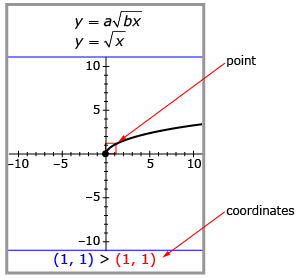Explore
In Try This 1 you explored what happened to the shape of a graph when you multiplied all of the x-coordinates of a function by a constant or when you multiplied all of the y-coordinates by a constant. The change in shape seen is called a stretch. In this lesson you will focus on stretches about the x-axis or the y-axis. When you're stretching about an axis, it is useful to think of a function in terms of the equation y = af(bx). In Try This 2 you will explore the outcomes of changing a and b for a function of this form.
Try This 2
Open Stretching/Reflecting y = af(bx).
- Select the square root function button
 .
.
Notice the point highlighted on the function that follows. This highlighted point shows where a particular point moves as you adjust a and b. The original coordinates and transformed coordinates of this point are listed at the bottom of Stretching/Reflecting y = af(bx). Make sure you pay attention to this information during Try This 2.

- Drag the red point along the graph to (4, 2); then use the applet to complete a table like the one that follows.
Value of a
Value of b
Coordinates of Original Point
Coordinates of Transformed Point
Description/Diagram of How the Point Changed
Description/Diagram of How the Function Changed
1
1
(4, 2)
(4, 2)
no change
no change
3
1
0.7
1
−2
1
1
4
1
0.5
1
−2
Student Choice
Student Choice
- For positive a- and b-values, what effect does each of the following have on a function?
- increasing a
- decreasing a
- increasing b
- decreasing b
- Press the “SET FCN” button on the applet and experiment with a different function. Do you still agree with your responses from question 3?
![]() Save your work in your course folder.
Save your work in your course folder.
Share 2
With a partner or group, discuss the following questions based on the table you created in Try This 2.
- What effect does a negative a or b have on the function? Where have you seen this effect before?
-
- What mathematical relationship is there between a and how an individual point on the function y = af(bx) moves?
- What mathematical relationship is there between b and how an individual point on the function y = af(bx) moves?
- Where would you expect to find an invariant point for each type of stretch?
